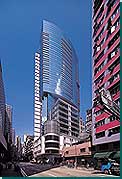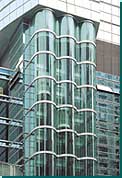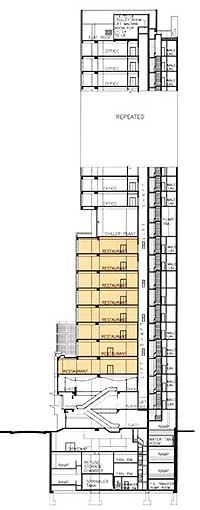| June
2000 |

 |
|
|
Olympia Plaza
Olympian
landmark
Among its tight-knit environs,
Fortress Hill has gained a new landmark development in the form
of Olympia Plaza. Jim Tong, Director of Wong Tung and Partners,
discusses the design approach for the mixed-use development
 Architects
Wong Tung and Partners Ltd were commissioned to design the Ka Chee-developed
mixed-use complex in 1993. With the Tenancy Tribunal process completing
in January 1996 and the subsequent site clearance later that year,
the designers were offered a lengthy period in which to refine their
blueprints. The site -- previously home to the Olympia Theatre and
a residential block -- occupies an end block abuting King's
Road, Power Street
and Electric Road. "The brief for this project was fairly unusual
in that the site is quite small," explains Tong. "That's
why we've adopted
this so-called tripartite approach, even on the design of the elevation,
to express all the functions." The written brief from the client
called for a maximum number of carparking spaces, a shopping arcade
covering three to four floors, eight restaurant floors -- the "vertical
food street" -- and office space above at the 1,357 sq m site.
The design solution places all car parking underground in five levels,
four being split levels, containing 50 to 60 carparking spaces and
unloading areas. The first three levels above ground are shopping
arcades topped by the restaurants. The office tower tops out the
three-part elevation, bringing the total height to 119 metres, or
26 storeys. Architects
Wong Tung and Partners Ltd were commissioned to design the Ka Chee-developed
mixed-use complex in 1993. With the Tenancy Tribunal process completing
in January 1996 and the subsequent site clearance later that year,
the designers were offered a lengthy period in which to refine their
blueprints. The site -- previously home to the Olympia Theatre and
a residential block -- occupies an end block abuting King's
Road, Power Street
and Electric Road. "The brief for this project was fairly unusual
in that the site is quite small," explains Tong. "That's
why we've adopted
this so-called tripartite approach, even on the design of the elevation,
to express all the functions." The written brief from the client
called for a maximum number of carparking spaces, a shopping arcade
covering three to four floors, eight restaurant floors -- the "vertical
food street" -- and office space above at the 1,357 sq m site.
The design solution places all car parking underground in five levels,
four being split levels, containing 50 to 60 carparking spaces and
unloading areas. The first three levels above ground are shopping
arcades topped by the restaurants. The office tower tops out the
three-part elevation, bringing the total height to 119 metres, or
26 storeys.
The tripartite approach
The elevation comprises three key segments -- podium, food and beverage
areas and office floors. Each use is clearly defined through the
exterior treatment. As Tong explains: "You can dress it up
to be just one uniform skin but we have chosen to express it through
different treatments to give more a sculptural quality."
The podium
"One of the early requirements from the client was that the
elevation of the podium has to contain many lightbox signages for
advertising. That's
why other than the two very important corners, we have these stretched
canvas signs. And the building corners recieve quite special treatment,
both along the corners of Power Street and King's
Road, and Power Street
and Electric Road. They form cylinders to fully express the function
of the building inside -- at night all these will glow with light.
People can see in as well as see out and the cylinders will be acting
as beacons while you are travelling at high speed along the two
important roads. We have dramatised the effect by adding the glass
cube top on top of the cylinder." The glass blocks conceal
air-conditioning units by day but at night they glow as a column
of light.
The podium, as with the
floors above, is clad only in glass and metal to achieve a modern
look, says Tong. Ventilation requirements for fire prevention called
for windows on the podium levels. These are recessed beyond the
plane of the signages to create a pattern against the canvas panels
and the aluminium-clad structural frame.
The restaurant floors
The vertical food street is recessed from the podium, providing
eight floors of catering encased in clear glazing. Access to the
restaurants is via three glass elevators overlooking King's
Road, encased in a
novel curvilinear curtain wall system developed by the architects
in tandem with the curtain wall supplier. "We want the elevators
to be very visible from outside the building to attract patrons
to the reastaurants. They also animate the building because of the
movement of the lifts. These are a very unusual construction in
that the entire glass cage is suspended -- you don't
see too many supports
from outside. If you look very closely, especially if you are inside
the lifts, you can see tiny stainless steel rods hanging down from
the top to support all the glass.
"Another feature
is that the walls of the lift lobbies are also glass. While you
are waiting for the lift you can see through two layers of glass
and appreciate the views around the building.
The curves of the King's
Road-facing elevator
shafts are balanced on the opposite end of the restaurant floorplates
-- above Electric Road, triangular forms rise up the elevation in
reflective glass between the podium and the office floors.
The office levels
"We refer to it as the olive-shaped tower above the restaurant
floors," Tong says. The fluid elevation is clad in reflective
glass and stands in contrast to the more angular designs below.
Horizontal aluminium projections pass across the face of the building
as an architectural feature. On the uppermost floors, the curved
elevation delivers views from Fortress Hill across to Causeway Bay
and Victoria Harbour.
Behind the office floors
and stretching back down to the podium deck is a fin-like back panel.
"Essentially, it helps to cover up the side of the old building
next door and it also serves as a very large advertising sign for
the building itself and also all the restaurant floors. Each restaurant
floor will have a corresponding advertising panel."
 Going
inside Going
inside
Fronting Power Street, the base of the building is set back, offering
pedestrians a wide stone-lined pavement beneath an aluminium paneled
canopy encircling the three elevations. Entrances are provided on
and Electric and King's
Roads. Visitors pass beneath a curved aluminium canopy to enter
the podium mall. The canopy, says Tong, makes the building more
fluid and echoes the circles on the plan.
The ground floor of the
arcade uses a "T"-shaped plan indoors to link the three
street entries. Escalators lead up to the first and second floors
in a central escalator well through which the three mall levels
can be viewed. The two upper levels of the podium use "D"-shaped
corridors to create a continuous loop of circulation. The second
floor opens out into a lift lobby for the office component and resturants.
"The site is too small to have yet another lobby downstairs"
explains Tong. "Otherwise you would have no space for shops.
Office workers have to go through two tiers of escalators before
reaching the main lobby on the second floor." The arrangement
boosts traffic in the retail portion and grants more exposure to
the restaurants. On each floor of the podium, fire escapes and service
areas take up the rear corner towards King's
Road.
The main floor features
what Tong refers to as the wave ceiling -- curvilinear aluminium
panels stretching actross the escalator well, divided by gaps left
clear for lighting and cleaning purposes. Elsewhere in the podium,
the ceilings use metal fins tilted at an angle and featuring cold
cathode strips and downlighter accents. The office lift lobby and
other vertical surfaces feature walls clad in acid-etched mirrors
-- the reflectivity is muted in a very light green tint to give
a soft effect and a spacious feel to the lobby. Flooring is man-made
stone sourced from Italy, arranged with corresponding colours in
a common pattern. The tiles are placed in white for the top floor,
yellow for the floor below and blue at street level.
In the office component,
the floorplates are designed for maximum efficiency. "We used
up the maximum permitted site coverage for these floors to gain
as large a floorplate as possible so that the office can be flexible;
you can use it as one office or subdivide it into many smaller offices,"
says Tong. A gridded ceiling subdivides square panels and office
lighting, and the curtain wall is in modules with the ceiling grid.
"Whenever you put a partition along the ceiling grid, you always
hit a mullion; you won't
end at the middle of a plane of glass." To acheive this, the
designers met the problem of standardising the dimensions of the
glass planes on the curved elevation ?as the elevation curves away
from its central axis, spaces between where the ceiling grid meets
the curved wall become wider. "Ultimately we have decided to
use two glass sizes so that they can best match the runners."
The services core is placed at the rear to house three lift shafts,
staircases and the essentials -- washrooms and air handling plant
rooms for the VAV air-conditioning system.
Making an impact
Once fully occupied, the 20,596 sq m GFA Olympia Plaza will hold
an unmistakeable presence at nightfall. Spotlights are set into
the stone sidewalk to light ground floor columns while a line of
feature lights pronounces the first floor canopy. The canvas advertising
panels are set to glow in bursts of colour around the podium while
the smaller light panels rise up the tower's
back panel in a similar
display of backlit promotion. The two glazed cylinders with glass
blocks above will light up as the intended beacon while the restaurant's
interior lighting
will stream out through the clear glass.
architect Wong Tung &
Partners Limited
Principal: Edward ST Ho
Design Director: Jim KP Tong
Project Director: Ivan PH So
Project Team: Adrian Ip, Ann Ma, Amy Lo
developer Ka Chee Company Ltd
structural engineer Joseph Chow & Partners Ltd
M&E engineer Meinhardt (M&E) Ltd
quantity surveyor Davis Langdon and Seah (Hong Kong) Ltd
external cladding consultant Arup Facade Engineering
main contractor Gammon Construction Ltd
|

 Architects
Wong Tung and Partners Ltd were commissioned to design the Ka Chee-developed
mixed-use complex in 1993. With the Tenancy Tribunal process completing
in January 1996 and the subsequent site clearance later that year,
the designers were offered a lengthy period in which to refine their
blueprints. The site -- previously home to the Olympia Theatre and
a residential block -- occupies an end block abuting King's
Road, Power Street
and Electric Road. "The brief for this project was fairly unusual
in that the site is quite small," explains Tong. "That's
why we've adopted
this so-called tripartite approach, even on the design of the elevation,
to express all the functions." The written brief from the client
called for a maximum number of carparking spaces, a shopping arcade
covering three to four floors, eight restaurant floors -- the "vertical
food street" -- and office space above at the 1,357 sq m site.
The design solution places all car parking underground in five levels,
four being split levels, containing 50 to 60 carparking spaces and
unloading areas. The first three levels above ground are shopping
arcades topped by the restaurants. The office tower tops out the
three-part elevation, bringing the total height to 119 metres, or
26 storeys.
Architects
Wong Tung and Partners Ltd were commissioned to design the Ka Chee-developed
mixed-use complex in 1993. With the Tenancy Tribunal process completing
in January 1996 and the subsequent site clearance later that year,
the designers were offered a lengthy period in which to refine their
blueprints. The site -- previously home to the Olympia Theatre and
a residential block -- occupies an end block abuting King's
Road, Power Street
and Electric Road. "The brief for this project was fairly unusual
in that the site is quite small," explains Tong. "That's
why we've adopted
this so-called tripartite approach, even on the design of the elevation,
to express all the functions." The written brief from the client
called for a maximum number of carparking spaces, a shopping arcade
covering three to four floors, eight restaurant floors -- the "vertical
food street" -- and office space above at the 1,357 sq m site.
The design solution places all car parking underground in five levels,
four being split levels, containing 50 to 60 carparking spaces and
unloading areas. The first three levels above ground are shopping
arcades topped by the restaurants. The office tower tops out the
three-part elevation, bringing the total height to 119 metres, or
26 storeys.  Going
inside
Going
inside